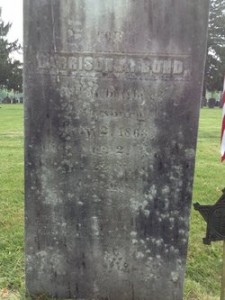In the first week of July, 1863, the Armies of the North and South were marching toward a small southern Pennsylvania town called Gettysburg. The 22nd Regiment Massachusetts Volunteer Infantry was one of those units on the march.
By July 1, 1863, the 22nd had reached Hanover Pennsylvania unaware that the Army of the Potomac had engaged the enemy a few short miles away. They had marched 10 miles and were bone weary tired so they bedded down for the night however, their sleep would not last long. They were required to get back on their feet and continue the march to reach the battle field early the next morning. They were able to catch a few hours of sleep while they awaited orders.
Around 4pm on July 2nd they were ordered, along with elements of the 5th Corps to fall in and support the 3rd Corps. The marched just north of little round top, made famous by the 20th Maine and it’s commander Colonel Joshua Chamberlain, but they would not stop there. They were deployed just south of the Wheatfield within sight of the Rose farmhouse. Knowing that they would have to hold that small section of ground for the foreseeable future, they began to pile their paper cartridges in front of them for easy access during the fighting.
The 22nd was formed on September 28, 1861 in Boston for a period of service of three years. Of the 1,100 men that mustered in only 125 would return home at the end of their three years of service. More than 300 were killed in action and another 500 were discharged due to their wounds or other illness. 11 men from the Central Massachusetts town of Southbridge enlisted in Company K of the 22nd regiment and were present in the Wheatfield on the afternoon of July 2nd.
Southbridge sent more than 400 men to fight in the Civil War and I have embarked on a project to located and identify the graves of all 400 of these men, many of whom did not return to Southbridge. One of the names that on that list is Harrison Bond, and he plays a crucial role in this story.
Harrison Bond was 20 years old when he enlisted in the 22nd Regiment. He lived in Southbridge and was employed as a weaver. Harrison Bond was present in the Wheatfield in fact he was wounded in the battle there. He was transported to Camp Letterman, an Army Field Hospital set up on the George Wolfe Farm and it was there, on August 22, 1863 that Harrison Bond died of the wounds that he sustained during the Battle of Gettysburg.
His body was returned to his home and he is buried in the Cemetery in Brimfield, Massachusetts. A few weeks back I traveled to that cemetery in search of the grave and found it, among graves of Revolutionary War Veterans, with a Grand Army of the Republic Flag Marker to denote his service, and his sacrifice, for his country. Not much more is known of him as I cannot find any other information about him.
There is nothing remarkable about Harrison Bond by all accounts he was an ordinary guy that enlisted to fight to preserve the Union. Who know why he answered the call in September of 1861 but like the thousands of others he did his duty.
It is easy to remember the names of Robert E. Lee and Ulysses S. Grant but the names like Bond, Calvert, Parkhurst are all but lost to history. It was the Private soldier, the ones who left their families and their occupations, men like Harrison Bond, that fought the good fight and their names will be lost in time.
This is the second of what I hope will be several essays on the American Civil War. The first essay can be found here.


1 Comment
Comments are closed.